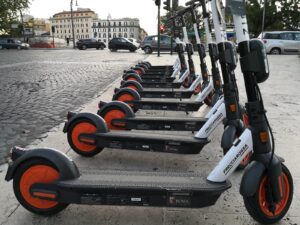Micro-Mobility for Europe (MMfE) – a coalition of shared micro-mobility providers – have attempted to tackle the thorny issue of how e-scooters and e-bikes are parked with a new report titled: Parking Challenges & Recommendations.
The issue of parking is a headache for almost everyone: pedestrians, micro-mobility users and the operating companies themselves. Obviously, providing the e-scooters and e-bikes is one thing, providing space for them to be parked is not something they can do.
As such, responsibility falls to the local authorities to provide parking space that doesn’t impinge on other road and pavement users.
MMfE address four specific challenges that are faced: a lack of dedicated parking, competition for urban space, public education gaps and compliance measurement and enforcement.
The first of those is the most obvious and most time is spent addressing it. In dense urban areas, it is suggested that mandatory physical parking spaces need to be created, with a minimum of 40 per sq/km and three parking spaces should exist for each vehicle. Other recommendations are:
- Make use of existing bicycle rack infrastructure so long as there is enough room for private bicycles
- Replace car parking spaces
- Locate physical infrastructure to complement public transport
- Consider safety when picking parking locations
- Use incentives to direct riders to parking infrastructure and education about local parking rules
- Stationless parking for less dense areas
Competition for urban space refers to situations in which physical infrastructure is lacking, or where stationless parking is not obviously defined. This can lead to antagonism and e-scooters being moved by car drivers in order to park where the scooter was parked or by a private bicycle owner moving a scooter out of a bicycle rack in order to lock their bike to the rack.
This leads on to the public education gaps. Survey data reveals that lack of knowledge of parking rules is a major contributor to poor parking in cities, and that riders often copy how other riders have parked. To counter this, MMfE suggest that cities and operators should offe training events and digital training tools to educate riders and potential riders.
Users of shared micro-mobility services should be provided with tailored information about parking in any specific city when opening the app, in combination with parking training information that is available at all times.
Compliance has two elements: rider compliance with parking rules and operator compliance with rules as measured by the city. Enforcing rider compliance, it is recommended, should be done in a way so as not to penalise people disproportionately to those using other modes such as private cars or private micro-mobility vehicles. Additionally, cities and operators should work together to ensure that misparking was the fault of a rider before using rider fines or bans.













